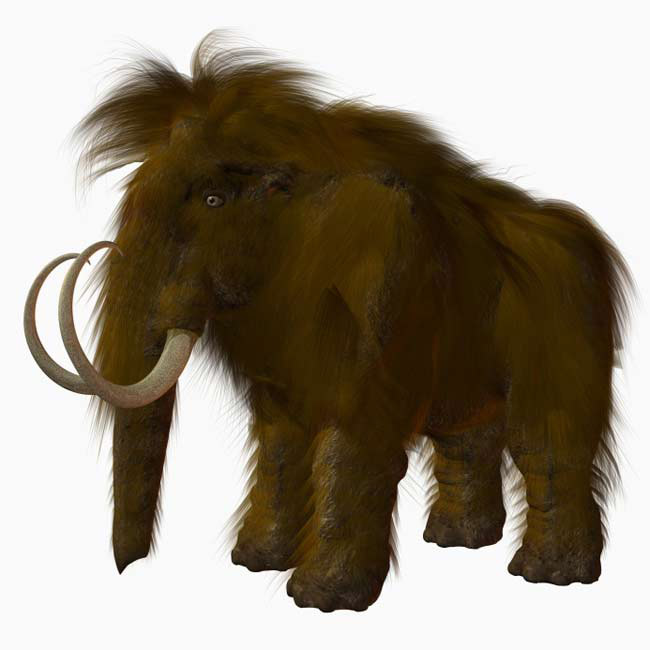Comet Killed Ice Age Beasts

Space rocks that slammed into the glaciers of eastern Canada some 12,900 years ago likely helped wipe out mega-animals like woolly mammoths and possibly the continent's first human inhabitants called the Clovis people, according to a new study that adds to evidence that a trio of factors were involved.
The new evidence comes from recently discovered nano-sized diamonds, which researchers say are the strongest clues to date for an argument that could explain the region's die-off during the late Pleistocene epoch.
Scientists have long debated what caused this catastrophic extinction event, sending more than three-fourths of North America's large Ice Age animals and the Clovis people to their graves. (The Clovis people were a Stone Age group that had only recently immigrated to the continent.)
To date, two major explanations — human overhunting and climate change — were insufficient by themselves to account for the mega die-off. But add in the comet impact, and all three factors may have combined to create a deadly "perfect storm," said study researcher Allen West of GeoScience Consulting in Arizona.
"There's no way to tell what percentage each one of those three things played in the demise of the megafauna. But almost certainly all three were involved – impact, climate change and humans," West said.
The comet culprit isn't a new idea. Scientists have reported finding comet evidence such as nanodiamonds, glass-like carbon and the rare Earth element iridium. But this is the first time scientists have reported hexagonal diamonds. These so-called lonsdaleite nanodiamonds have been found only in meteorites or impact craters.
"[Lonsdaleite] forms under very high temperatures and pressures consistent with a cosmic impact," said study team member Douglas Kennett, an archaeologist at the University of Oregon. "These diamonds have only been found thus far in meteorites and impact craters on Earth and appear to be the strongest indicator yet of a significant cosmic impact [during Clovis]."
Get the world’s most fascinating discoveries delivered straight to your inbox.
Diamond discovery
The team discovered the tiny diamonds below 13 feet (4 meters) of sediment in Arlington Canyon, which is located on the island of Santa Rosa. This island was once connected to three other Northern Channel Islands off the Southern California coast in a landmass known as Santarosae.
The researchers have also found the hexagonal diamonds at other sites across North America and Europe.
From the diamond evidence and other material, here's how the researchers think the demise went down: One or a few comet-like objects up to about a mile (2 km) across smacked into Canada. The comets must have hit at an oblique angle, the researchers say, blowing away a good portion of ice — explaining why scientists have yet to find a crater.
The impact would have triggered a wave of massive wildfires, something supported by soot found in the area with the nanodiamonds at the Santa Rosa site and others across North America. Such fires could have incinerated nearby megafauna and humans.
The comet's effects could also be responsible for the extinction of the pygmy mammoth from the Northern Channel Islands, the researchers say.
Mega chill
The longer-term effects would have killed most of the lingering survivors.
"An explosion like this of a comet injects a lot of water vapor (comets are made of water ice) so it basically would've put clouds over most of the Northern Hemisphere," West said. "That's going to make things get very cool very quickly."
Plus, the wildfires would have loaded the atmosphere with sun-blocking dust, soot, water vapor and nitric oxides. The result would be abrupt climate cooling.
In fact, West and his colleagues think the cosmic impact also caused a cooling period known as the Younger Dryas.
"It would be a little like if you're living in Miami and suddenly, within less than a year, the climate turns the equivalent of Montreal, Canada. It means palm trees couldn't grow," West told LiveScience.
Plants adapted to the warmer climes would have died, leaving little food for the roaming giants, West said.
West and his colleagues are still trying to figure out exactly how the hexagonal nanodiamonds and other diamond varieties found at this 12,900-year-old layer of sediment formed. The researchers suggest the high-pressure, high-temperature impact converted graphite on Earth into the hexagonal diamonds. In addition, some of the carbon-dioxide ice within the comet itself could have transformed into such rare nanodiamonds upon impact.
The National Science Foundation provided primary funding for the research, which is detailed this week in the journal Proceedings of the National Academy of Sciences.
- Top 10 Deadliest Animals
- New Recipe: How to Make a Mass Extinction
- Top 10 Ways to Destroy Earth
Jeanna Bryner is managing editor of Scientific American. Previously she was editor in chief of Live Science and, prior to that, an editor at Scholastic's Science World magazine. Bryner has an English degree from Salisbury University, a master's degree in biogeochemistry and environmental sciences from the University of Maryland and a graduate science journalism degree from New York University. She has worked as a biologist in Florida, where she monitored wetlands and did field surveys for endangered species, including the gorgeous Florida Scrub Jay. She also received an ocean sciences journalism fellowship from the Woods Hole Oceanographic Institution. She is a firm believer that science is for everyone and that just about everything can be viewed through the lens of science.


